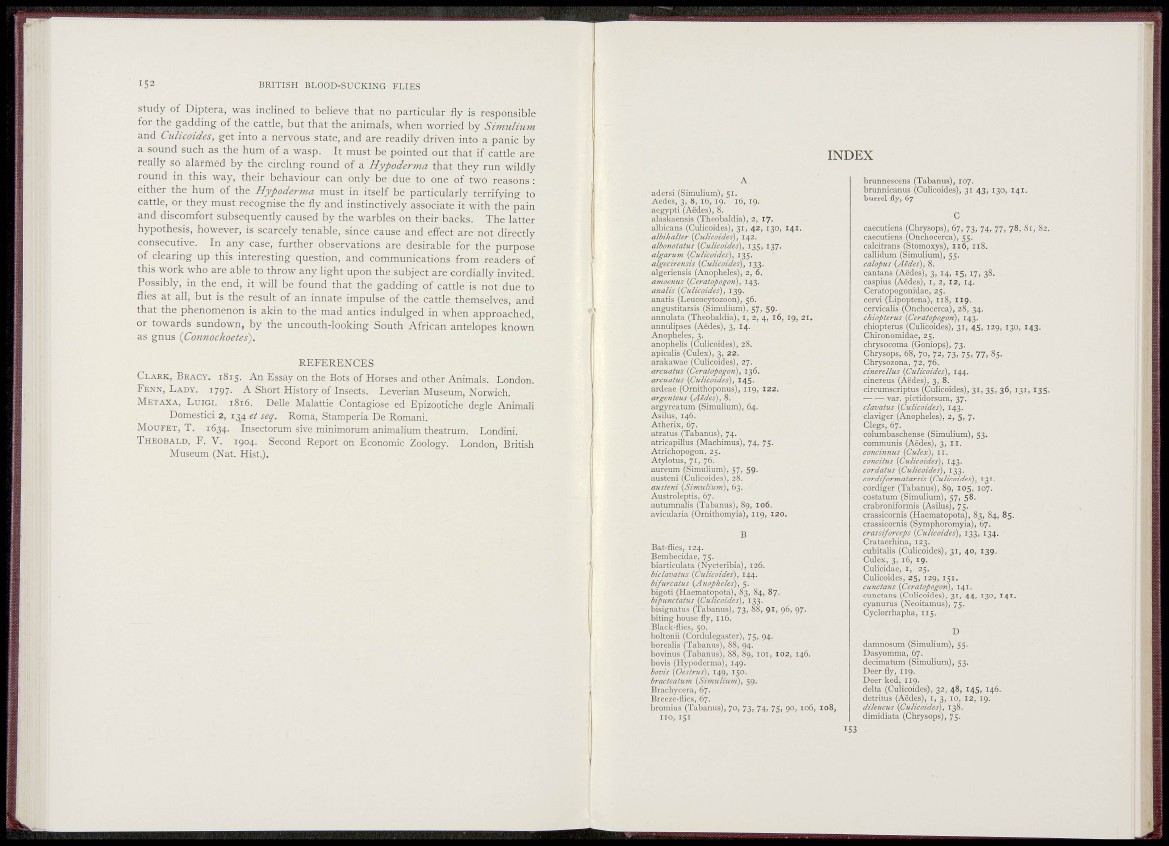
B R I T I S H BLOOD-SUCKING FLIES
Study of Diptera, was inclined to believe that no particular fly is responsible
for the gadding of the cattle, but that the animals, when worried by Si?nulium
and Culicoides, get into a nervous state, and are readily driven into a panic by
a sound such as the hum of a wasp. It must be pointed out that if cattle are
really so alarmed by the circling round of a Hypoderma that they run wildly
round in this way, their behaviour can only be due to one of two reasons :
either the hum of the Hypoderma must in itself be particularly terrifying to
cattle, or they must recognise the fly and instinctively associate it with the pain
and discomfort subsequently caused by the warbles on their backs. The latter
hypothesis, however, is scarcely tenable, since cause and effect are not directly
consecutive. In any case, further observations are desirable for the purpose
of clearing up this interesting question, and communications from readers of
this work who are able to throw any light upon the subject are cordially invited.
Possibly, in the end, it will be found that the gadding of cattle is not due to
flies at all, but is the result of an innate impulse of the cattle themselves, and
that the phenomenon is akin to the mad antics indulged in when approached,
or towards sundown, by the uncouth-looking South African antelopes known
as gnus {Connochoetes).
REFERENCES
CLARK, BRACY. 1815. An Essay on the Bots of Horses and other Animals. London.
FENN, LADY. 1797. A Short History of Insects. Leverian Museum, Norwich.
METAXA, LUIGI. 1816. Delia Malattie Contagiose ed Epizootiche degle Animali
Doniestici 2, 134 et seq. Roma, Stamperia De Romani.
MOUFET, T. 1634. Insectorum sive minimorum animalium theatrum. Londini.
THEOBALD, F. V. 1904. Second Report on Economic Zoology. London, British
Museum (Nat. Hist.).
INDEX
A
adersi (Simulium), 51.
Aedes, 3, 8, i6, 19. 16, 19.
aegypti (Aedes), 8.
alaskaensis (Theobaldia), 2, 17.
albicans (Culicoides), 31, 42, 130, 141.
albihalter {Culicoides), 142.
albonotatus {Culicoides), 135, 137.
algarum {Culicoides), 135.
algecirensis {Culicoides), 133.
algeriensis (Anopheles), 2, 6.
anioenus {Ceratopogon), 143.
analis {Culicoides), 139.
anatis (Leucocytozoon), 56.
angustitarsis (Simulium), 57, 59.
annulata (Theobaldia), I, 2, 4, 16, 19, 21.
annulipses (Aedes), 3, 14.
Anopheles, 3.
anophelis (Culicoides), z8.
apicalis (Culex), 3, 22.
arakawae (Culicoides), 27.
arcuatus {Ceratopogon), 136.
arcuatus {Culicoides), 145.
ardeae (Ornithoponus), 119, 122.
argenteus {Aedes), 8.
argyreatum (Simulium), 64.
Asilus, 146.
Atherix, 67.
atratus (Tabanus), 74.
atricapillus (Machimus), 74, 75.
Atrichopogon, 25.
Atylotus, 71, 76.
aureum (Simulium), 57, 59.
austeni (Culicoides), 28.
austeni {Simulium), 63.
Austroleptis, 67.
autumnalis (Tabanus), 89, 106.
avicularia (Ornithomyia), 119, 120.
B
Bat-flies, 124.
Bembecidae, 75.
biarticulata (Nycteribia), 126.
biclavatus {Culicoides), 144.
bifurcatus {Anopheles), 5.
bigoti (Haematopota), S3, 84, 87.
bipunciaius {Culicoides), 133.
bisignatus (Tabanus), 73, 88, 91, 96, 97.
biting house fly, 116.
Black-flies, 50.
boltonii (Cordulegaster), 75, 94.
borcalis (Tabanus), 88, 94.
bovinus (Tabanus), 88, 8g, loi , 102, 146.
bovis (Hypoderma), 149.
bovis {Oestrus), 149, 150.
bracteatujn {Simulium), 59.
Brachycera, 67.
Breeze-flies, 67.
bromius (Tabanus), 70, 73, 74, 75, 90, 106, 108,
n o , 151
brunnescens (Tabanus), 107.
brunnicanus (Culicoides), 31 43, 130, 141.
burrel-fly, 67
caecutiens (Chrysops), 67, 73, 74, 77, 78, 81, 82.
caecutiens (Onchocerca), 55.
calcitrans (Stomoxys), 116, ri8.
callidum (Simulium), 55.
calopus {Aedes), 8.
cantans (Aedes), 3, 14, 15, 17, 38.
caspius (Aedes), i, 2, 12, 14.
Ceratopogonidae, 25.
cervi (Lipoptena), 118, 119.
cervicalis (Onchocerca), 28, 34.
chiopterus {Ceratopogon), 143.
chiopterus (Culicoides), 31, 45, 129, 130, 143.
Chironomidae, 25.
chrysocoma (Goniops), 73.
Chrysops, 68, 70, 72, 73, 75, 77, 85.
Chrysozona, 72, 76.
cinerellus {Culicoides), 144.
cinereus (Aedes), 3, 8.
circumscriptus (Culicoides), 31, 35, 36, 131, 135.
— •— var. pictidorsum, 37.
clavatus {Culicoides), 143.
claviger (Anopheles), 2, 5, 7.
Clegs, 67.
columbaschense (Simulium), 53.
communis (Aedes), 3, 11.
concinnus {Culex), 11.
concitus {Culicoides), 143.
cordatus {Culicoides), 133.
cordiformatarsis {Culicoides), 131.
cordiger (Tabanus), 89, 105, 107.
costatum (Simulium), 57, 58.
crabroniformis (Asilus), 75.
crassicornis (Haematopota), 83, 84, 85.
crassicornis (Symphoromyia), 67.
crassiforceps {Culicoides), 133, 134.
Crataerhina, 123.
cubitalis (Culicoides), 31, 40, 139.
Culex, 3, 16, 19.
Culicidae, I, 25.
CuHcoides, 25, 129, 151.
cuncta7is {Ceratopogon), 141.
cunctans (Culicoides), 31, 44, 130, 141.
cyanurus (Neoitamus), 75.
Cyclorrhapha, 115.
D
damnosum (Simulium), 55.
Dasyomma, 67.
decimatum (Simulium), 53.
Deer fly, 119.
Deer ked, 119.
delta (Culicoides), 32, 48, 145, 146.
detritus (Aedes), I, 3, 10, 12, 19.
dileucus {Culicoides), 138.
dimidiata (Chrysops), 75.
m